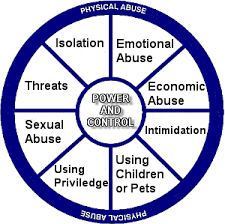Wheel of violence
Many people mistakenly believe that the term"domestic violence" only means physical abuse or assaults. Physical abuse is only one part of a system of abusive behaviors. The wheel of violence is commonly used by domestic violence prevention agencies, support programs and shelters to explain what characterizes abusive relationships. Below is an outline of the wheel with a description of how each characteristic is used as a way to control or gain power.
Battering and abusing is a choice. It is used to gain power and control over another person. Abuse is never a one time event. It is actually the use of systematic control through many methods. See the cycle of abuse outline below to understand how the abuse is enacted and revolves in the relationship.

POWER and CONTROL - Abusers believe they have a right to control their partners by:
- Telling them what to do and expecting obedience
- Using force to maintain power and control over partners
- Feeling their partners have no right to challenge their desire for power and control
- Feeling justified making the victim comply
- Blaming the abuse on the partner and not accepting responsibility for wrongful acts.
The characteristics shown in the wheel are examples of how this power and control are demonstrated and enacted against the victim.
ISOLATION
- limiting outside involvement
- making another avoid people/friends/family by deliberately embarrassing or humiliating them in front of others
- expecting another to report every move and activity
- restricting use of the car
- moving residences
EMOTIONAL ABUSE
- putting another down/name-calling
- ignoring or discounting activities and accomplishments
- withholding approval or affection
- making another feel as if they are crazy in public or through private humiliation
- unreasonable jealousy and suspicion
- playing mind games
ECONOMIC ABUSE
- preventing another from getting or keeping a job
- withholding funds
- spending family income without consent and/or making the partner struggle to pay bills
- not letting someone know of or have access to family/personal income
- forcing someone to ask for basic necessities
INTIMIDATION
- driving recklessly to make another feel threatened or endangered
- destroying property or cherished possessions
- making another afraid by using looks/actions/gestures
- throwing objects as an expression of anger to make another feel threatened
- displaying weapons
USING CHILDREN or PETS
- threatening to take the children away
- making the partner feel guilty about the children
- abusing children or pets to punish the partner
- using the children to relay messages
USING PRIVILEDGE
- treating another like a servant
- making all the big decisions
- being the one to define male and female roles
- acting like the master or queen of the castle
SEXUAL ABUSE
- sex on demand or sexual withholding
- physical assaults during sexual intercourse
- spousal rapes or non-consensual sex
- sexually degrading language
- denying reproductive freedom
THREATS
- threats of violence against significant third parties
- threats to commit physical or sexual harm
- threats to commit property destruction
- threats to commit suicide or murder
PHYSICAL ABUSE
- biting/scratching
- slapping/punching
- kicking/stomping
- throwing objects at another
- locking another in a closet or utilizing other confinement
- sleep interference and/or deliberately exhausting the partner with unreasonable demands and lack of rest
- deprivation of heat or food
- shoving another down steps or into objects
- assaults with weapons such as knives/guns/other objects
Cycle of abuse
There are four typical stages including:
TENSION BUILDING - Tension starts and steadily builds
- Abuser starts to get angry
- Communication breaks down
- Victim feels the need to concede to the abuser
- Tension becomes too much
- Victim feels uneasy and a need to watch every move
INCIDENT or "Acting Out" phase
- Any type of abuse occurs
- Physical
- Sexual
- Emotional
- Or other abuses in the wheel above
HONEYMOON or Reconciliation phase
- Abuser apologizes for abuse, some beg forgiveness or show sorrows
- Abuser may promise it will never happen again
- Blames victim for provoking the abuse or denies abuse occurred
- Minimizing, denying or claiming the abuse wasn't as bad as victim claims
CALM before the tension starts again
- Abuses slow or stop
- Abuser acts like the abuse never happened
- Promises made during honeymoon stage may be met
- Abuser may give gifts to victim
- Victim believes or wants to believe the abuse is over or the abuser will change
This cycle is different in each abusive relationship. In some cases a relationship may take hours or up to a week to complete the cycle. For other relationships, it may take a month, or it may even take a year or more for a relationship to complete the cycle. As the relationship continues, the Calm and Honeymoon stages may even disappear. It is important to note that not all domestic violence relationships fit the cycle. Usually the cycle is completed faster as the relationship progresses - meaning the quiet and loving times are less frequent and the abuse returns more rapidly and lasts longer. Over time, serious injuries to the victim will often escalate as well as the frequency of the abuses and battering.
Källa
|